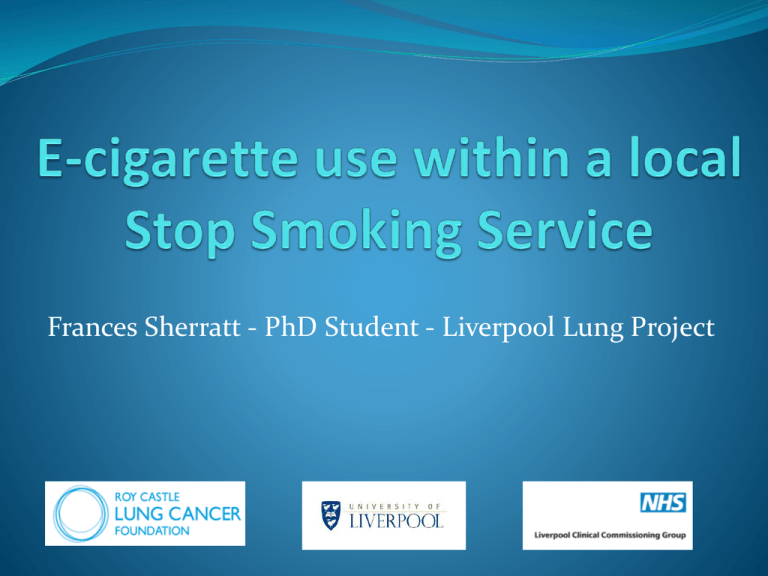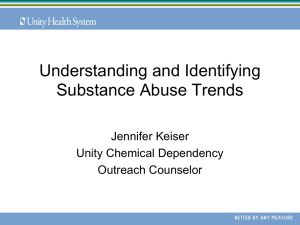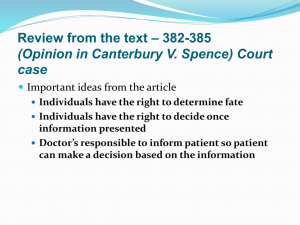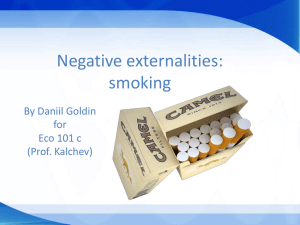
Frances Sherratt - PhD Student - Liverpool Lung Project
• The rise of electronic cigarette use
• The current e-cig study
• Implications for future research and practice
The Independent. ‘Put it in my mouth’: Viewers outraged by apparent reference to oral sex in VIP e-cig
advert [photograph]. Retrieved from http://www.independent.co.uk/news/media/advertising/put-it-inmy-mouth-viewers-outraged-by-apparent-reference-to-oral-sex-in-vip-ecig-advert-8982918.html
Mingay, Jane (for The Telegraph). The Great British Vape-off debate. [photograph]. Retrieved from
http://www.telegraph.co.uk/health/10747395/The-Great-British-Vape-off-debate.html
Marketing Magazine. E-Lites secures product placement 'first' in Lily Allen's 'Hard Out Here' video
[photograph] Retrieved from http://www.marketingmagazine.co.uk/article/1220802/e-lites-securesproduct-placement-first-lily-allens-hard-here-video
• ASH (2014)
- 2.1 million e-cig users in the UK
- 1/3 former smokers and 2/3 current
smokers
• Herzog [Wells Fargo Securities] (2013)
- E-cig sales surpass regular cigarettes?
ASH (2014)
• Short term toxicity – low. Long term -
unknown (Bertholon et al., 2013)
• Improvements in spirometry data (Polosa et
al., 2014)
• Long term carcinogenic and lung function
effects unknown (Drummond & Upson, 2014)
• The regulation of e-cigs has been welcomed to
ensure they are safe and effective (BMA, 2014;
ASH, 2014)
• IASLC advises against recommending using
them presently (Cummings et al., 2014)
• Beard et al. (2014) [In Dec 2012] practitioners
reported:
- No users – 10.4%
- Less than a quarter of clients - 52.3%
• Variability in practitioner advice
• Limitation – no objective data
• To ascertain the demographic characteristics
associated with e-cigarette use.
• To explore patterns of e-cigarette use.
• To examine e-cigarette risk perceptions.
• To identify contributing factors of e-cig use.
• Participants (n = 256)
• Roy Castle FagEnds, Liverpool
• Consent acquired within drop-ins
• Questionnaire completed
• E-cig use not associated
with
marital status,
E-cigarette use by
sex
ethnicity, age, or educational attainment
(p = 0.87, p = 0.31, p = 0.72, p = 0.65,
respectively)
• E-cig use more common among females
(p<0.05)
70
60
No. of participants
50
40
Female
30
Male
20
10
0
Current
Former
E-cigarette use
Never
• Current 18.8%/ former 30.5%/ never 50.8%
E-cigarette use by smoking status
• Majority:
80
- used within past month (53.8%)
- viewed e-cigs as a short-term smoking cessation
aid (75.4%)
- used their e-cig ≤15 times per day (70.9%), with
44% using it less than 5 times per day
• Many used the e-cig in a place where they
wouldn’t normally smoke (35.4%)
• Significant association between e-cig use and
smoking status (p < 0.05)
70
No. of participants
60
50
40
Current smokers
Former smokers
30
20
10
0
E-cig current
E-cig former
E-cig status
E-cig never
Perceptions of e-cig risk compared
to e-cig use
• E-cig risk perception was associated with e-cig
80
use (p < 0.01).
• No association between e-cig risk perception
and smoking status, sex, marital status,
educational attainment and age.
70
Percentage of participants
60
50
E-cig current
40
E-cig former
30
E-cig never
20
10
0
Less harmful
As harmful
More harmful
Perceived risk of e-cigs
Don't know
• Common responses included:
- Dissatisfaction with current NRT products/
wanting to try something new (13.9%)
- Social encouragement or endorsement
(13.9%)
- A similar experience to smoking (13.2%)
• E-cig use prevalent in this SSS
• Use is higher among females and those who
perceive them to be less harmful
• Generally not excessive use but some evidence
of potentially problematic use
• Limitations:
- results based on self-reports
- recruitment from one SSS only
• Common use in SSS
- How does this impact on services?
• Excessive/long-term use
- Will this increase nicotine dependence?
- Feasibility of provision in SSS
• E-cig research priorities – further studies
regarding safety/ effectiveness
Roy Castle FagEnds staff and participants
Supervisors:
• Professor John Field
• Professor Jude Robinson
• Dr Michael Marcus
Funding:
• Liverpool Clinical Commissioning Group (PCT)
• Ede & Ravenscroft – travel grant






